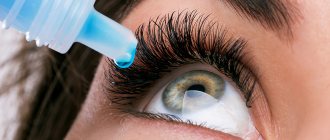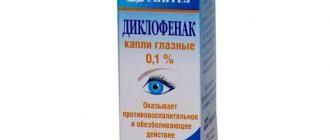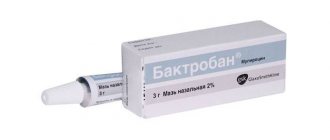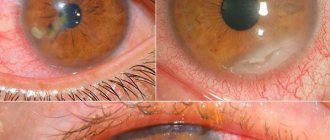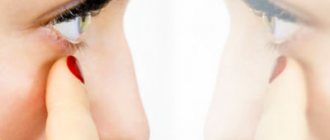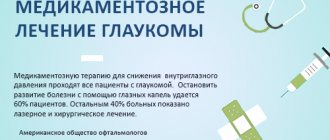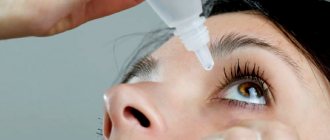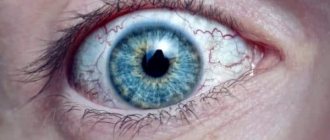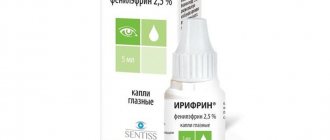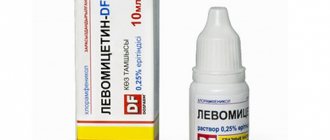Is conjunctivitis dangerous?
The prevalence of conjunctivitis in groups of children has allowed the formation of a strong public opinion about the mild course of the disease. Indeed, in most cases, the disease is short-lived, since the immune system of a healthy child is able to cope with it quickly. Therefore, many begin to treat the baby on their own without consulting a doctor, trusting the experience of other parents.
The content of the article
- Is conjunctivitis dangerous?
- Symptoms of viral conjunctivitis and treatment in children
- Can viral conjunctivitis go away on its own without treatment?
- Viral conjunctivitis: treatment
- Children's viral conjunctivitis: treatment and prevention
This approach can cause complications and the development of dangerous ophthalmological diseases. With viral conjunctivitis in children, a bacterial infection often appears, which the baby brings into the eyes through his hands, experiencing itching, burning and other unpleasant symptoms and not receiving adequate help. A child with a strong immune system can quickly cope with the disease. If the protective functions of the baby’s body are weakened, the treatment will be long-term, even with the use of antiviral medicine. Among the dangerous complications of viral conjunctivitis are blepharitis, keratitis, phlegmon and other inflammatory processes affecting the cornea and the surface of the eyelids. Treatment of complications of conjunctivitis in children is long-term, more than one to two months.
Symptoms of viral conjunctivitis and treatment in children
For viral conjunctivitis, treatment should begin as soon as the first symptoms of the disease appear, although the symptoms increase slowly and may seem like just a temporary eye irritation. What are the symptoms and treatment of this disease? At the very beginning of the disease, the mucous membrane of one eye is affected, then the conjunctiva of the second becomes inflamed. The disease can be isolated or concomitant. During the period of adenoviral infections, cases of isolated viral conjunctivitis predominate, which is transmitted both through the air, non-contact, and through shared objects.
Viral concomitant conjunctivitis develops against the background of viral diseases: chickenpox, rubella, measles. The symptoms of such conjunctivitis weaken as soon as the acute period of the underlying disease passes. For viral conjunctivitis, treatment is carried out using drugs that are active against adenoviral, herpetic, and enteroviral infections. It is necessary to be treated under the constant supervision of a doctor, since viral conjunctivitis is severe and can be accompanied by skin rashes, fever, and pneumonia.
Viral conjunctivitis in children - symptoms:
- acute pain in the eyes, severe redness and swelling of the conjunctiva - these signs of the disease most often prevail among the symptoms of conjunctivitis of various natures;
- profuse lacrimation, increased sensitivity to light sources, painful itching and burning are also some of the most common signs of viral conjunctivitis in a child;
- fever, sore throat, swollen lymph nodes;
- scanty purulent discharge - with viral conjunctivitis in children, there is rarely a lot of pus.
Conjunctivitis caused by the herpes virus is especially dangerous, as it is fraught with various complications. It can be recognized by symptoms such as swelling of the eyelids and skin rashes - there will be small, painful blisters on the surface of the upper eyelid. How is viral conjunctivitis, caused by the herpes virus, treated in children? Antiviral drops and ointments are used to treat herpetic conjunctivitis. The doctor may prescribe drugs such as Acyclovir, Zovirax, Lavomax, Oftalmoferon. For severe conjunctivitis, treatment will be carried out using glucocorticoid drugs.
Signs of ARVI in children and adults
When an acute respiratory viral infection takes hold and develops in the human body, the disease makes itself felt with several characteristic symptoms. In adults and children, the first thing to start to hurt is the throat, soreness and runny nose.
If left untreated, children and adults may become worse within a matter of days. The malaise gradually intensifies, and more serious signs of the disease appear. Such as:
- severe headaches;
- increase in body temperature to 37.5 degrees or higher;
- fever and chills;
- nasal congestion, sneezing;
- dry or wet cough;
- tearing eyes;
- general weakness in the body, aching joints;
- decreased vitality.
The intensity of symptoms depends on the stage of the disease. For ARVI, there are several of them:
- Incubation period. Characterizes a condition that occurs during the period between the penetration of viral agents into the body and the appearance of the first signs of illness. The incubation period is latent, that is, hidden, ARVI does not reveal itself in any way. People with good, strong immunity already at this stage have every chance of recovery, since the natural defense works hard and prevents the virus from spreading throughout the body.
- Stage of appearance of the first symptoms. This period occurs if the first stage of immune defense does not work. The virus actively multiplies on the surface of mucous membranes. Signs of this phenomenon include gradually increasing sore throat, body aches, fatigue, drowsiness, and decreased performance. This is a natural reaction of the immune system and body to toxins that are formed as a result of the activity of viruses.
- The height of the disease. The period is characterized by high virus activity, when pathogens destroy the mucous membrane of the nasopharynx, penetrate the bloodstream and integrate into the structure of healthy cells of the body. Because of this, the symptoms of ARVI increase: body temperature rises, cough occurs, runny nose worsens, headache, sneezing, and chills appear. The immune system at this stage continues to work, trying to neutralize foreign pathogens.
- Recovery. Signs of ARVI become less obvious, the patient's condition improves.
A similar process occurs in people with strong, normal immunity. But if it is weakened, then the disease has every chance of becoming protracted. This is fraught with new consequences and complications. Therefore, you should not ignore the first signs of the disease; you need to start treatment as early as possible. It’s better to prevent the disease altogether, including using nasal drops to prevent ARVI in adults and children.
Can viral conjunctivitis go away on its own without treatment?
Inflammation of the eyes, conjunctivitis, if they arose as concomitant diseases with chicken pox, measles, can go away along with a weakening of the symptoms of the main disease. Isolated viral conjunctivitis must be treated, since the very fact that the virus has infected the conjunctiva signals that not everything is in order with the child’s body. Doctors recommend treating children with drops; in addition, they may prescribe the use of ointment. Human tear fluid has antibacterial and antiviral effects. Normally, bacteria, viruses and fungi that enter the mucous membrane are neutralized by the action of lysozyme, which is part of the tear. If a child’s immunity is weakened, his body becomes vulnerable to the spread of viral and bacterial infections, so conjunctivitis should be treated by a local pediatrician or therapist. In difficult cases, consultation with an ophthalmologist will be required.
What causes the disease? Predisposing factors for the development of conjunctivitis:
- hypothermia or overheating;
- metabolic disorder;
- decreased reactivity of the immune system against the background of long-term illnesses;
- infectious diseases.
How to treat inflammation of the mucous membrane of the eyes, with what medications? Viruses, entering the mucous membrane and penetrating deep into the eyes, accumulate and release toxins, which then enter the blood. They weaken the protective functions of the mucous membrane of the upper respiratory tract, which causes the spread of pathogenic microflora and the development of a bacterial infection. If conjunctivitis is not treated with antiviral drugs, the amount of toxins will increase, which will lead to a deterioration in the child’s well-being and possible intoxication of the body.
Drugs to strengthen the immune system
Drugs and medications to enhance immunity
What is immunity?
Until recently, the achievements of modern medicine did not give cause for excitement. Antibiotics, vaccines, vaccinations - it seemed that all infections were under human control. But the COVID-19 pandemic has shown that infectious diseases have not ceased to be a threat. Interest in immunity has recently increased so much that the main goal of all humanity has become to find an answer to the question: “How to strengthen the immune system? How to protect yourself from infection? The year 1786 is considered to be the year when modern immunology began. It was then that the village doctor Edward Jenner noticed that milkmaids who had recovered from the cowpox virus were not susceptible to the smallpox virus, which was deadly at that time. Jenner identified a relationship: women have developed a defense that protects them from contracting a more severe disease. Over the next centuries, science has made great strides in understanding our immune system. Immunity is our body’s defense system against something foreign that is dangerous to us. The defense reaction begins from the moment the enemy “agent” is recognized, then it is removed and the negative traces of this infection in the body are eliminated. In the structure of immunity, two types can be distinguished: innate and acquired. Innate immunity acts immediately. Its soldiers: phagocytes, interferons, inflammatory mediators. As soon as the enemy is spotted, he is destroyed. Acquired immunity is more complex. When an enemy is detected, the body forms an immune response, creates specialized cells against this infectious agent, and only then eliminates it. This type of immunity allows you to remember the infection and react much faster next time. Thus, in the memory of acquired immunity there is a whole list of our “enemies”. Moreover, this list is individual for each person. Special organs are responsible for the production of cells involved in protecting the body. These are the thymus gland (or thymus) and bone marrow. Cell maturation and selection occur in them. And the launch of these processes is helped by the lymph nodes located in the area of large joints (shoulder, elbow, knee, hip) and in the neck. They, connected by lymphatic vessels, serve as filters for antigens, retaining them and activating protective reactions. Immunity also depends on the intestinal microflora. It is believed that 70% of the immune system is located there. The task of this area is to recognize dangerous particles entering through the oral cavity and neutralize them, and pass less dangerous ones on so that the body reacts to them and develops protective cells. Thus, immunity is the totality of all organs and cells in the body that recognize and destroy foreign substances. Represented by completely different cells and organs, the immune system acts as a single defense mechanism, constantly strengthening and improving under the influence of external factors. Why do we still get sick? If the immune system is constantly on guard, why do some bacteria or viruses make us sick? Because we live surrounded by microbes and it is impossible to completely isolate ourselves from them. But this is not necessary! After all, there are not only “bad” bacteria, but also “good” bacteria. And in small quantities they are like a free vaccine - they only increase our defenses. Therefore, sterilizing everything around and constantly taking antibiotics is completely unnecessary and even harmful. In order to prevent infection, it is enough to support your immune system and wash your hands thoroughly. We cannot influence the actions of infected people, but we can adjust our lifestyle and increase our level of protection. Now, when most countries are talking about introducing quarantine, when we are forced to stay at home, we need to think about preventive measures and maintaining health. Against the backdrop of isolation, the usual routine is disrupted, the sleep schedule is disrupted, physical activity is practically zero, and bad habits in the diet, on the contrary, take over. A lot of sweets, alcohol, excess food - all this in the long term negatively affects the immune system and the condition of the body as a whole.
Signs of reduced immunity?
Sometimes the immune system becomes inhibited.
He begins to distinguish infections in the body less well, does not react to them so sharply - a disease arises. And sometimes, on the contrary, it is too active and begins to attack not only foreign enemy cells, but also harmless cells of the native organism. In such cases, we talk about autoimmune processes, these include: gluten intolerance, rheumatoid arthritis, multiple sclerosis, systemic lupus erythematosus, autoimmune Hashimoto's thyroiditis. Let us examine in more detail the first situation, when the body’s defenses are reduced. What should you pay attention to? 1) Frequent respiratory viral diseases and bacterial infections; 2) Lung damage due to respiratory diseases with a protracted and severe course (infection from the upper sections quickly descends into the lower sections of the respiratory system and damages the lung tissue); 3) Frequent pustular inflammation of the skin. The skin is a barrier organ; it resists the penetration of infection inside. But with a decrease in immunity, the infection begins to develop, penetrating from the superficial layers of the skin to the deeper ones. Frequent boils, inflammation of the eyelids (styes), abscesses - all these are signs of a weakening of the body's defenses; 4) Fungal infections of nails, skin, mucous membranes. When fungal diseases develop, a dynamic equilibrium most often occurs. That is, the fungus tries to penetrate deep into the body, but cannot, and the immune system tries to suppress and reject the infection, but also cannot do this. In this case, the process becomes chronic and can last for years; 5) Recurrent diseases of the ENT organs (for example, frequent inflammation of the throat or rhinitis) and the genitourinary system (inflammation of the bladder, inflammation of the kidneys); 6) Long-term healing of wound surfaces. For minor injuries, complete wound healing occurs within 14 days. In cases of immunodeficiency, healing occurs much more slowly, and the most dangerous thing is that a bacterial infection may occur and the development of purulent complications. With reduced immunity, patients experience weakness, worsening mood, drowsiness, chronic fatigue, decreased mobility and frequent headaches. There are also factors in which immunity deficiency is detected in most cases. These include chronic stress, lack of sleep, old age, menopause in women, and even the time of year. It has been revealed that during the cold period the frequency of diseases increases, so it would not be superfluous to maintain the body’s immune forces by external forces. How to strengthen your immune system?
Strengthening the immune system should take place in a comprehensive manner.
Strengthening measures include: 1) Correction of lifestyle and nutrition; 2) Taking medications to maintain and strengthen immunity. Lifestyle consists of several factors: physical activity, emotional state, sleep, nutrition and the absence of bad habits. Moderate physical activity is important at any age. With their help we maintain normal body weight. And normal body weight is the basis of a strong immune system. Aerobic exercise: light jogging, walking, cycling - reduces the risk of seasonal diseases by almost half. There are studies showing the positive effect of physical activity on the intestinal microflora. But it is precisely this that is one of the main links in the immune system. After just a month of constant physical activity, bacteria accumulate in the intestines, which produce substances that strengthen the immune system. Also, playing sports causes the renewal of immune cells, which have greater protective activity, unlike old cells. Our emotional state directly affects our immune system. With prolonged predominance of any emotional reaction, the immune system is depleted and weakened. Constant stress, prolonged aggression or anger, depression and even prolonged social isolation cause exacerbation of chronic diseases and an increased risk of acquiring new diseases. And vice versa - positive emotions and hobbies (meditation, handicrafts, watching funny and kind films) allow the body to cope with infections faster. Sleep is an important process during which the information received during the day is processed, cells are renewed, and the body’s strength is replenished. With a lack of sleep, the immune system weakens and the speed of reaction to the causative agent of the disease slows down. Sometimes such a slowdown is enough for the development of a full clinical picture of the disease and the occurrence of complications in the body. The amount of sleep should be at least 7-8 hours. It is no coincidence that when someone gets sick, they feel increased sleepiness, because this is an excellent way to recuperate. Nutrition. The most important thing in nutrition is maintaining balance. Many people understand the dangers of excess nutrition - too much trans fats, fast food, sweets and starchy foods reduce your defenses. But nutritional deficiency also negatively affects a person. Food is a source of building material for the cells of our body. And the quality of this material depends on us. A balanced diet and sufficient water content in the diet are important. Alcohol and smoking have a detrimental effect on the functioning of the immune system. Restoring immunity implies complete or almost complete abandonment of these bad habits. In addition to all the important aspects of a healthy immune system listed above, it is necessary to understand that medicine does not stand still. Scientific communities constantly prove or disprove the activity of certain substances in relation to immunity. To get onto the market, a pharmaceutical drug undergoes clinical trials, in which it proves its safety and positive effect on the immune system. A group of such active substances belongs to immunostimulants (immunomodulators). Types of immunostimulants:
— Homeopathic remedies;
— Natural preparations; — Medicines based on bacteria; — Medicines based on interferon; — Vitamins to protect the immune system (Vitamin C, Vitamin A, Vitamin D); — Products based on the thymus gland; Homeopathic medicines
Treatment with homeopathic medicines is classified as alternative medicine.
The effect of such medications is more complex, gentle, and natural; these medications are usually sold over-the-counter. It is important to understand that completely abandoning traditional methods of treatment in favor of homeopathy is not safe. Such remedies can only be considered in complex treatment. Aflubin
A natural complex drug for the prevention and treatment of viral diseases.
Contains three active plant components - gentian, aconite and bryonia. According to the manufacturer's research, it has an immunomodulatory effect and is able to reduce inflammatory processes in the body. Antiviral activity is also observed when taking the drug. The drug is available in the form of tablets and drops. For the prevention of ARVI and influenza, adults and children over 12 years of age are recommended to take 1 tablet or 10 drops of the drug 2 times a day for 3 weeks. Children under 12 years old - 1/2 tablet or 5 drops 2 times a day. Taken 30 minutes before meals or 1 hour after meals. Preparations of natural origin
According to WHO estimates, about 80% of the world's population uses herbal preparations as medicine. Many people with mild to moderate illnesses prefer to resort to herbal medicines as a more useful and environmentally friendly way to fight infection. Herbal teas, infusions and decoctions help not only in maintaining immunity, but also in restoring strength after illness.
Spirulina-VEL
Spirulina is a blue-green algae containing a huge variety of microelements. The uniqueness of spirulina is that it contains beta-carotene (Vitamin A) and phycocyanins. Phycocyanin is a powerful natural immunostimulant and antioxidant. It has a positive effect on bone marrow stem cells, cells involved in the destruction of antibodies (macrophages) and the thymus gland, and also reduces the number of free radicals, which prevents the development of cancer. It has a positive effect on intestinal microflora, hair and skin condition. It is recommended to take 2 tablets 3 times a day with meals. The drug is approved for use in children. Since spirulina is a freshwater algae, the iodine content in Spirulina-VEL is low. But people with an overactive thyroid gland should consult their doctor before use. Echinacea
At the moment, there are many studies claiming the high effectiveness of echinacea as an immunostimulant. The active compounds of polysaccharides, essential oils and flavonoids contained in the plant stimulate the production of leukocytes and immunoglobulins, and also accelerate their movement and activity at the site of infection. Echinacea is available in the form of solutions, tinctures, tablets or capsules. The manufacturer recommends taking 1 capsule per day for 2-3 weeks, as the effect is cumulative. Echinacea also has contraindications: people with hypersensitivity to the components of the drug, as well as those suffering from autoimmune diseases (rheumatoid arthritis, lupus erythematosus, multiple sclerosis) should refrain from taking echinacea and consider other options for maintaining immunity. Medicines based on bacteria (bacterial lysates). Bacterial lysates are fragments of bacterial cells that have lost their viability, but still have immune activity. The first such drugs appeared in the 70s of the 20th century. Over the past time, many convincing studies have appeared proving their clinical effectiveness. The purpose of such drugs is not only to activate the immune system to destroy the infection, but also to reduce the severity of the inflammatory reaction, i.e. reducing the symptoms of colds and alleviating the patient’s condition. In the presence of a focus of chronic infection, therapy with bacterial lysates makes it possible to completely eliminate this focus. The inclusion of bacterial immunomodulators in therapy (especially respiratory infections) reduces the need for anti-inflammatory and antibacterial drugs, which has a positive effect on the entire body. Broncho-munal
One of the most popular drugs in the group of bacterial lysates. The drug contains components of 8 bacteria. These are the strains that most often cause respiratory tract infections. Once inside the body, the drug affects the intestinal mucosa, where immune response cells are concentrated. Then these active cells are sent to the tissues of the respiratory tract, where they realize their protective functions. In addition, the drug increases the production of other immune cells (cytokines and interferons), which generally increases the body's defenses. The drug can be used in both adults and children from 6 months. Available in capsule form in dosages of 7 mg (for adults) and 3.5 mg (for children). Contraindication: pregnancy and lactation. Dosage: 1 capsule per day in the morning, 1 hour before meals. For prevention, the duration of use is 10 days, then a break of 20 days. During illness, the drug is taken until symptoms disappear, but for at least 10 days. Ismigen
Ismigen, like all bacterial lysates, activates several parts of the immune system at once. This is both local immunity and systemic immunity. Activates phagocytosis (i.e. absorption of infectious cells by the body), increases the number of immune cells, increases the concentration of immunoglobulins. As a result of treatment, the duration of the active period of respiratory infection is reduced, symptoms of fever and cough are alleviated, and the need for antibacterial drugs is reduced. For recurrent respiratory tract diseases (chronic bronchitis), the drug prevents exacerbation, helping to avoid the manifestation of clinical symptoms of the disease. The product is available in the form of tablets, which are placed under the tongue in the morning on an empty stomach until completely absorbed. 1 tablet per day for 10 days is enough to achieve the effect. It is used both in children from 3 years old and in adults. Contraindications include pregnancy and lactation, as well as individual intolerance to the components of the drug. Interferon-based medications
Interferons and interferon inducers (i.e., drugs that provoke the production of interferon in the body) can be classified as drugs with a pronounced immunomodulatory effect.
Although drugs in this group are more antiviral, the interferon molecule is part of the immune system, affecting all parts of the immune system. Interferon stimulates the bone marrow, activates macrophages and other specific cells of the immune system. Research shows that after the introduction of interferon inducers into the body, a general (nonspecific) defense of the body is formed, which can remain at a high level for weeks, in contrast to interferon produced in the body (it loses its activity much earlier). Interferon inducers do not cause antigenic activity (i.e., they do not activate drug rejection). Even a single administration of such drugs causes long-term production of interferon. Cycloferon
A low molecular weight interferon inducer with high biological activity. The drug is able to retain and strengthen its own antiviral immunity. Cycloferon has a high safety profile, which allows its use in people with chronic diseases. The drug is available in the form of ointments, tablets and injections. When taking tablets, it is enough to take one tablet once a day, in the morning, 1 hour before meals. Children are allowed from 4 years of age. The drug is prescribed according to a special regimen, the treatment lasts about 3 weeks. Cycloferon is most often used in the treatment of acute respiratory viral infections, but its use is also permissible for prevention, especially when contact with an infected person has been identified. Amiksin
The problem with antiviral drugs is their suppressive effect on the immune system. Amiksin is one of the few drugs in this group that not only has a detrimental effect on a wide range of viruses, but also stimulates the body's immune defense. There are a number of studies proving that against the background of prophylactic administration of the drug, the incidence of ARVI decreased by 3.6 times! If the appointment was carried out for therapeutic purposes, then the duration of the disease was shorter, as was the frequency of complications due to ARVI. The active ingredient of Amiksin is tilorone, which was synthesized in the 70s of the twentieth century. Amiksin is available in tablet form. Admission is allowed for children from 7 years of age and adults. To prevent influenza and acute respiratory viral infections, only 1 tablet per week is used for 6 weeks. Vitamins to strengthen the immune system. Microelements are substances contained in the body in small quantities, but are extremely important for the normal functioning of all organs, including the immune system. These include 13 essential vitamins and about 20 minerals. Their deficiency can lead to various metabolic diseases. Deficiencies of vitamins C, A and D have a particularly negative effect on the immune system. Vitamin C
Vitamin C is found in almost all fruits and vegetables to a greater or lesser extent. It acts as an antioxidant and is involved in the production of antibody cells, in the process of reproduction of macrophages, and enhances their activity and mobility. Thanks to Nobel Prize-winning chemist Linus Pauling, taking high doses of vitamin C has become so popular that it is still the first vitamin recommended for colds. But an excess of the vitamin is just as negative as its deficiency. Therefore, for a positive effect from taking it, you should focus on average daily doses, namely 65-90 mg per day, depending on age. Vitamin A
A trace element that supports vision, growth and development of the body. It stabilizes the functioning of the immune system, protecting it from infections, as it has a positive effect on the health of the skin, mucous membranes, respiratory system, stomach and intestines. That is, it takes part in building a barrier to infections. It is important to understand that high dosages of retinol (vitamin A of animal origin) also have a negative effect if the person using it is addicted to smoking. Therefore, when taking high doses of vitamin A, consultation with a doctor is necessary. Vitamin D
It has long been known that vitamin D helps strengthen bone tissue, but relatively recently scientific research has confirmed the benefits of vitamin D in relation to immunity. Vitamin D is produced in the skin when exposed to sunlight. Our latitudes in autumn and winter do not allow us to receive the necessary portion of sunlight. At the moment, some doctors are of the opinion that it is preferable to avoid sun exposure due to harmful ultraviolet radiation, and therefore vitamin D should be taken all year round, simply adjusting the dose for the spring and summer. Sunlight also speeds up the movement of certain types of immune cells throughout the body, increasing the speed of response to pathogens. With a high content of vitamin D, it is easier for the body to fight diseases such as multiple sclerosis, asthma, cardiovascular diseases, and cancer. It helps maintain barrier functions in our skin, intestines and lungs, and helps suppress excess immune responses in the body, preventing the development of autoimmune diseases. An overdose of vitamin D is also undesirable. It can lead to a significant increase in calcium levels in the blood. Therefore, it should be taken in consultation with a doctor and without exceeding the doses indicated in the instructions for use. For example, the drug Aquadetrim is recommended up to 2 drops per day for preventive purposes. Preparations of the thymus gland. The thymus is a small organ in which the maturation of cells of the immune system occurs. In humans, the thymus develops before puberty, then with age it undergoes reverse development. In old age, it is barely distinguishable from surrounding tissues. Timalin
It is a highly purified extract from the thymus gland of calves, which helps restore the immune response, stimulates the production of immune cells, the processes of regeneration and hematopoiesis. This drug is used intramuscularly as an injection. For prophylactic purposes, it is prescribed for adults 5-10 mg daily, for children over 6 months 1-5 mg daily for 3-5 days. Polyoxidonium
The drug has a complex action, therefore it is somewhat different from the above groups. The uniqueness of the drug lies in its activity. It is able to fight not only viruses, but also fungal and bacterial diseases. It is suitable for patients with high allergenic sensitivity, as it does not contain plant components or bacterial DNA components. Polyoxidonium is recommended for active inflammation, to reduce symptoms of intoxication and for the prevention of acute respiratory viral infections in frequently ill patients. Form of release of the drug: lyophilisate, suppositories, tablets. Lyophilisate is used in children from 6 months, suppositories and tablets are approved for use in children from 3 years of age. The immune system is responsible for all areas of our health, both physical and emotional. In order for our defense to be constantly ready, it needs help. Immune health is a state of the entire body, achieved not only by taking medications, but also by lifestyle, and even thinking. It is in our hands to help the immune system today so that it protects us tomorrow. Be healthy! BIOLOGICALLY ACTIVE SUPPLEMENT. NOT A MEDICINE. THERE ARE CONTRAINDICATIONS. YOU MUST READ THE INSTRUCTIONS OR CONSULT A SPECIALIST.
Viral conjunctivitis: treatment
Viral conjunctivitis in adults is treated with antiviral drugs, but how to cure viral conjunctivitis in a child? First of all, you need to seek help from a qualified specialist to reduce the risk of complications. An important point in the treatment of children is the implementation of the treatment plan drawn up by the doctor, because in the first days of the disease, with obvious and painful symptoms, eye drops, for example, Ophthalmoferon, will need to be used at short intervals, up to 6 times a day. As the severity of symptoms weakens, the number of instillations of drops is reduced to 2-3 times.
Ophthalmoferon eye drops have a wide spectrum of action, they have antiviral and anesthetic effects. The drops contain interferon, which forms a protective barrier against viruses and stimulates cellular resistance, so that the virus does not spread further. The effectiveness of the drug is high, which avoids complications and shortens the period of the disease. You should not rely only on folk remedies, washing your eyes with herbal decoctions, because such actions can only slightly ease the symptoms, but are powerless against the spread of the virus. How to treat viral conjunctivitis in children? What medications can a pediatrician prescribe?
Viral conjunctivitis - treatment:
- Combined drugs aimed at relieving pain and inflammation of the eyes in children, swelling of the eyelids, restoring the normal state of the mucous membrane of the eye.
- Antiviral ointments - they must be placed behind the eyelid; if the swelling is severe and painful, then use the ointment after the pain-relieving drops begin to take effect, about twenty minutes later.
- Moisturizing drops - such drops eliminate the feeling of dry eyes, create a uniform tear film; for children it is better to choose preparations without preservatives, such as Hilo-Komod drops.
- Multivitamins - they are prescribed by the doctor, taking into account the child’s age, tendency to allergies, etc.
With viral conjunctivitis, the purulent discharge is scanty, and yet regular and careful care of the surface of the eyes is necessary to prevent the development of a bacterial infection. Use warm solutions of antiseptics (furacilin) to clean your eyes, carefully removing purulent discharge, moving from the outside of the eyelid to the inside. In order to protect other children from contracting viral conjunctivitis, communication between the sick child and the team must be limited for the entire period of treatment. Parents of the baby must observe hand hygiene and also provide the child with fresh scarves and towels, which must be ironed before use. If the course of viral conjunctivitis is complicated by a bacterial infection, then not only antiviral drugs will be needed, but also broad-spectrum antibiotics.
Effective antiviral eye drops
The pharmaceutical industry produces a lot of antiviral drops; below is a list of the most popular and effective antiviral eye drops that can be bought at any pharmacy.
Oftalmoferon
Ophthalmoferon contains diphenhydramine and alpha-2a-interferon as therapeutic components. The drug exhibits antiviral antimicrobial activity, stops the inflammatory process, has a local anesthetic effect, and accelerates the healing of damaged tissues.
In the acute period, the drug should be instilled 1-2 drops up to 6-8 times a day. After the unpleasant symptoms of infection have weakened, the frequency of instillations is reduced to 2-3 times a day. It is recommended to use drops until signs of infection disappear. To ensure that the medicine does not lose its therapeutic properties, it must be stored at a temperature of 2-8 degrees for 24 months from the date of production. Oftalmoferon is a prescription drug.
Oftan I'm coming
Oftan Idu contains idoxuridine as an active ingredient, to which cytomegaloviruses and herpesviruses are sensitive.
During the acute phase of the disease, the drug is instilled every hour during the day, and every 2 hours at night. When symptoms weaken, the frequency of use is reduced. To avoid relapse after the signs of infection disappear, it is recommended to instill the drug for another 3 to 5 days.
The maximum duration of therapy is 3 weeks. If no positive dynamics are observed within 3-5 days, you need to change the eye drops.
Poludan
Poludan is available in the form of a lyophilisate and is used to make eye drops. The therapeutic effect of the drug is explained by polyriboadenylic and polyribouridylic acids of the potassium salt.
Eye drops have a pronounced antiviral effect and exhibit immunomodulatory activity. After instillation, the formation of interferon begins in the body, which can be detected in the blood and tear fluid 3 hours after instillation.
To prepare eye drops, add 2 ml of water to the contents of the bottle. The prepared solution should be stored in the refrigerator for no more than a week.
The treatment regimen depends on the patient’s age:
- For adults, the medication should be instilled 1-2 drops up to 6-8 times a day; when the signs of the disease weaken, the frequency of administration is reduced to 3-4 times;
- For persons under 18 years of age, in the acute period, instill the drug 3-4 times a day; as the unpleasant symptoms weaken, the frequency is reduced to 1-2 times.
If after a week of therapy there is no effect, it is recommended to consult an ophthalmologist. The lyophilisate must be stored at a maximum temperature of 8 degrees, for 4 years from the date of release of the medicine. The drug should be protected from exposure to direct sunlight.
Aktipol
Aktipol contains para-aminobenzoic acid as a medicinal substance. The drug has an antiviral effect, increases immunity, accelerates healing of the cornea. After instillation, the drug is quickly absorbed in the anterior segment of the eye and has a therapeutic effect.
For infections caused by herpes viruses and adenoviruses, instill the drug 1 or 2 drops up to 6-8 times a day, after the signs of the disease have passed, the frequency of administration is reduced to 3 times, treatment should be continued for another 3-5 days.
Actipol enhances the effect of antiviral drugs based on acyclovir and ganciclovir. It cannot be combined with albucid.
The drug does not lose its therapeutic effect at temperatures from -18 to +40 degrees. The shelf life of the drug is 24 months, but after opening the bottle, eye drops must be used within 2 weeks. Aktipol should be kept in a dark place inaccessible to children.
Okoferon
Okoferon is produced in the form of a lyophilisate from which eye drops are made. The drug contains α-2b-interferon as a therapeutic component. Nipagin solvent is included in the kit. It needs to be poured into the powder and shaken until the lyophilisate dissolves.
Instill the medication 2 drops every 2 hours for 7-10 days. Store eye drops at a temperature of 4 to 10 degrees for 2 years from the date of issue. After opening, keep the bottle in the refrigerator; the drops are good for 28 days.
Florenal
Florenal contains fluorenonylglyoxal bisulfate as a therapeutic component. The active substance is active against herpes viruses and adenoviruses.
Instill the drug 1 drop up to 6 times a day. The duration of therapy can vary from 1 to 2 weeks, in severe cases it is extended to 1-3 months. If after 10 days of treatment no positive dynamics are observed, it is recommended to change eye drops.
Store the drug at a temperature of 5 to 20 degrees. Eye drops cannot be frozen; their shelf life is 36 months.
Bactavit
Bactavit contains the antiseptic picloxidine dihydrochloride as an active ingredient. It causes the death of viruses, bacteria, fungi. Depending on the severity of the infection, instill eye drops from 2 to 6 times a day. The duration of treatment is 10 days, but the doctor can extend it.
How do the symptoms of viral conjunctivitis differ from bacterial ones?
Viral conjunctivitis begins with inflammation of one eye, there is noticeable redness, symptoms increase gradually, then the second eye may become inflamed. With a bacterial infection, a person’s condition worsens sharply, the eyelids swell so much that it is difficult to open the eyes after sleep. With the viral nature of the disease, there is severe lacrimation and the release of clear mucus, purulent discharge is scanty, and with bacterial infection, there is always a lot of purulent masses. Abundant purulent yellow discharge is the result of the toxic effects of bacteria on the tissues of the organs of vision. Viral conjunctivitis in a child should be treated with antiviral drugs, and bacterial conjunctivitis with antibiotics.
A qualified specialist can determine the nature of the disease based on the main symptoms, but the causative agent of the disease (adenovirus, herpes, streptococcus, staphylococcus, etc.) can only be identified by taking tests. Laboratory examination of scrapings from the conjunctiva is recommended if the symptoms are mixed and the disease is difficult to treat. Tests will help determine the cause of conjunctivitis and select appropriate medications to combat a specific virus or bacteria.
Children's viral conjunctivitis: treatment and prevention
Conjunctivitis often occurs in children with reduced immunity, so vitamin preparations are prescribed during eye treatment. To prevent this disease, it is very important to direct efforts to restore the protective functions of the child’s body. The more physical activity in the fresh air, the better, because a sufficient amount of oxygen helps the visual organs develop in accordance with age and without pathologies.
To prevent the development of dry eye syndrome due to prolonged interaction with smartphones, set-top boxes, and TV, it is necessary not only to limit the time spent using digital devices, but also to teach the child to take breaks during visual stress.
Special exercises for the eyes will improve the visual organs and help restore the optimal balance of tear fluid, which protects the eyes from the action of viruses and bacteria. Particular attention should be paid to nutrition, diversifying it with vegetables and fruits that are beneficial for the organs of vision and normal metabolism. The child’s menu should include foods rich in vitamins A, D, C, and lutein: eggs, sea fish, spinach, broccoli, rose hips, apricots, blueberries, carrots, legumes. A balanced diet will reduce the risk of ophthalmic diseases, including conjunctivitis.
What happens if ARVI is not treated promptly?
A common cold, which many people do not pay attention to, can have far-reaching consequences. The main “targets” of ARVI are the upper and lower respiratory tract and the nasal cavity. If you do not pay attention to inflammation for a long time, secondary infections may occur and concomitant diseases may develop. Thus, frequent “companions” of ARVI are:
- Bronchitis. It occurs with a strong cough and the production of viscous sputum. May not go away for a long time.
- Otitis. This inflammation of the ears is dangerous because during the disease, purulent discharge is formed, the ears hurt greatly, and “shoot.”
- Pneumonia. Inflammation of the lower respiratory system is the most dangerous complication that can occur against the background of ARVI. When pneumonia occurs, the patient has difficulty breathing, the process of inhalation and exhalation is accompanied by whistling, wheezing, a severe cough occurs, and phlegm and fluid may accumulate in the lungs.
- Sinusitis. Inflammation of the nasal sinuses leads to severe headaches, increased body temperature, and nasal obstruction.
When the disease is severe, more serious consequences are possible. For example, damage to the brain or heart, which requires longer treatment and rehabilitation.
For this reason, in order to maintain health, doctors advise not to ignore the signs of the disease, but to take action at the first symptoms and contact specialists who will prescribe suitable medications, including effective nasal drops for ARVI in adults and children.
